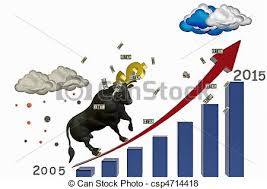Finance is a detailed study of how expenses should be managed and invested at a corporate as well as an individual level. The study has terms which acknowledge the generally occurring market phenomenon in analog with the animal traits. Get aboard and learn these funny wild financial terms:
- Bullish Market: It refers to a financial market where the price of the stock increases continuously. Some suggest that the term was drawn from the practice of bull- and bear-baiting, or even from the fighting styles of the two animals (a bear swipes down with its paws where a bull thrusts upwards with its horns).
- Bearish Market: It refers to a market where the price of the stocks is declining continuously. “Bear” probably extends from the idiom “to sell the bear’s skin before one has caught the bear.” These bearskin traders often sold their wares before actually receiving them, and would hope for a downturn in the market so that they might make a larger profit on the forward deal.
- Stag: A stag profit or stagging is when an individual or group buys into a company’s Initial Public offering (IPO) or issue of new shares with the intent of selling right away, hoping to take advantage of the rising stock price. The traders who participate in this practice are known as stags.
- Lame Duck: Lame duck term refers to someone who is a delinquent or entered bankruptcy. Ineffective traders would have been branded as “lame ducks,” for the way in which they “totter” out of the stock exchange.
- Stalking Dead Horse: An initial bid on a bankrupt company’s assets from an interested buyer chosen by the bankrupt company. From a pool of bidders, the bankrupt company chooses the stalking horse to make the first bid. This method allows the distressed company to avoid low bids on its assets. Once the stalking horse has made its bid, other potential buyers may submit competing bids for the bankrupt company’s assets. In essence, the stalking horse sets the bar so that other bidders can’t low-ball the purchase price.
- Cockroach Theory: Cockroach theory refers to the notion that unfavorable news about a company will, once publicized, be followed by similar reports about other companies in the industry.For example- The fact that one subprime lender (one cockroach) faced financial problems indicated that many other similar businesses were likely to face the same issues.
- Dead Cat Bounce: A dead cat bounce is a price pattern used by technical analysts. It is considered a continuation pattern, where at first the bounce may appear to be a reversal of the prevailing trend, but is quickly followed by a continuation of the downward price move. It becomes a dead cat bounce (and not a reversal) after price drops below its prior low. Short-term traders may attempt to profit from the small rally.
- Herd Instinct: In finance, a herd instinct would relate to instances in which individuals gravitate to the same or similar investments, based on the fact that many others are investing in those stocks. The fear of regret of missing out on a good investment is often a driving force behind herd instinct.At times herd instinct is responsible for increase in price of stocks without any fundamental firmness.
- Click here for government certification in Accounting, Banking & Finance




14 Comments. Leave new
well written article!!
Nice and different!
Very informative! Good one!
Nice title to the article. It was an interesting read.
Unique concept..! Great work..!
interesting article.
Interesting and informative.
Dats nice.. Intresting 🙂
Unique concept.. Good work
The temperaments of an animal help break down complex market analysis problems through this article.
Nice thought
nice…
Very well written.
the title of the article is very catchy !
explained it really well with the help of points !